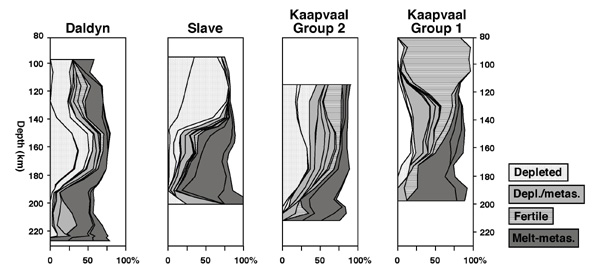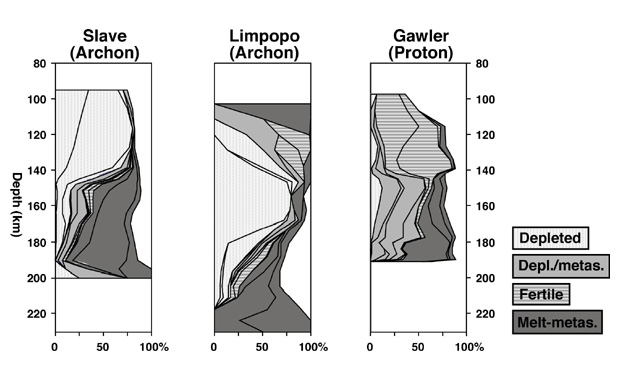Suzanne Y. O'Reilly1, W.L. Griffin1,2, B. Doyle3,
N.J. Pearson1, O. Gaul1and C.G. Ryan2
1 ARC National Key Centre for Geochemical Evolution and
Metallogeny of Continents, Macquarie University, NSW 2109 (www.es.mq.edu.au/GEMOC/)
2 CSIRO Exploration and Mining, North Ryde, NSW 2113
3 Kennecott Canada Inc., Vancouver, BC, Canada
The trace-element patterns of garnet and clinopyroxene grains in heavy-mineral concentrates derived from volcanic rocks contain detailed information about the composition and evolution of the lithospheric mantle (Griffin et al., 1999a). Novel statistical methods have been applied to a database of major- and trace-element data on mantle-derived Cr-pyrope garnets (n=18,000), to define 15 natural populations (classes). Comparison with similar data on garnets from 195 well-characterised xenoliths has then been used to identify the rock types and processes corresponding to individual classes. These can be grouped into broader classes: depleted harzburgites and lherzolites, depleted rocks metasomatically re-enriched in LIL and HFSE elements (commonly with phlogopite), fertile lherzolites, and low-mg# rocks affected by melt-related metasomatism. The distribution of these broad groups, and of individual classes, in the subcontinental lithospheric mantle (SCLM) varies with the tectonothermal age of the overlying crust. The secular evolution of SCLM composition (Griffin et al., 1998b) is expressed as a decrease in the proportions of the depleted and depleted/metasomatised classes from Archon to Tecton; the % of metasomatised rocks is highest in Proton SCLM. The apparent dramatic change in lithosphere composition near the end of the Archean, and an apparent more continual evolution to more fertile compositions since then, implies a major change in Earth's geodynamics in the late Archean.
The use of single-element thermometers allows the geochemical information for each grain to be placed in a depth context, so that vertical, lateral and temporal variations in mantle lithology can be mapped (Fig. 1). Data from a 1000-km traverse across the Siberian craton (Griffin et al., 1999b) show sharp discontinuities in mantle composition and stratigraphy within the Archean part of the craton, and between the Archean and Proterozoic parts. These breaks correspond with terrane boundaries mapped at the surface, indicating that the terrane boundaries are translithospheric and steeply dipping. This implies that individual terranes each carried their own distinctive lithospheric keel into the amalgamation of the craton. A similar traverse through South Africa and Botswana shows that different terranes within the Kaapvaal-Zimbabwe craton are underlain by distinctively different types of lithospheric mantle (Figs 1, 2). Mapping of the lithosphere beneath the central part of the Slave Craton of northern Canada (Fig. 1) shows a strongly layered lithospheric mantle, in which an ultradepleted upper layer (<100-150 km) is separated from a less depleted lower layer (150-220 km) by a sharp boundary. Clinopyroxene data show that the boundary between the layers localised strong metasomatic activity. Inversion of the garnet-olivine thermometer (Gaul et al., 2000) allows the use of garnet concentrates to derive the mean Fo content of olivine at any depth in the lithosphere, and shows a distinct change in mean Fo at the boundary between the layers. The presence of abundant diamonds with lower-mantle inclusion parageneses suggests that the lower layer was produced by the accretion of plume-derived material to the lower lithosphere.
Application of this technique reveals that several other
Archean and Proterozoic lithospheric sections worldwide show evidence for
a layered structure similar to that mapped in the Slave craton (Fig. 2).
Some of these sections also are known to contain lower-mantle diamonds,
suggesting that plume-related contributions to lithospheric growth may
be more common than previously recognised. In addition to these episodic
growth events, the SCLM probably has undergone a more continuous changes
in composition. Mapping of mantle sections in the same geographic region,
but sampled by eruptions widely separated in time, (eg older and younger
kimberlites in the SW Kaapvaal craton; Fig. 1) allows recognition of the
evolution of the mantle in specific areas. This approach, combined with
data on the

Figure 1. Mapping Archean Lithosphere. Columns show the distribution
with depth of garnet xenocryst classes (thin lines), grouped into those
derived parent rocks with different broad geochemical signatures: (1) Depleted
harzburgites and lherzolites, (2) Depleted rocks that have been partially
re-fertilised by metasomatism, (3) Fertile lherzolites, (4) Lherzolites
infiltrated by asthenospheric melts. The two sections from the SW part
of the Kaapvaal Craton represent different time slices; Group 2 kimberlites
are mainly intruded before 100 Ma, and Group 1 kimberlites are intruded
after 90 Ma. Plume-related metasomatism between these two events has changed
the lithosphere toward a less depleted overall composition, raised the
geotherm, and thinned the lithosphere by ca 30 km.

Figure 2. Examples of layered lithosphere, possibly related to plume subcretion. Columns constructed as in Figure 1. The Slave section shows a strongly depleted upper layer, underlain by a more normally depleted layer. The Limpopo section consists mainly of highly depleted rocks, underlain by a 15-25 km section of fertile lherzolites. The Gawler Craton (S. Australia) shows a relatively fertile upper part, separated by a sharp boundary from a more depleted lower half. All of these sections have yielded diamonds of the lower-mantle paragenesis, suggesting that plume-derived material has been added to the lithosphere; this process may account for the strong layering.
vertical distribution of metasomatic effects in lithosphere sections, suggests that Archean roots have been continuously modified over time by "leakage" of melts from the underlying asthenosphere.
Estimates of the density of SCLM of
different ages show that Archean SCLM is strongly buoyant relative to the
underlying asthenosphere and will resist delamination, whereas Phanerozoic
SCLM sections that have cooled to a stable conductive geotherm are neutrally
buoyant and susceptible to delamination (Poudjom Djomani et al., 2001).
However, data from several areas (e.g. eastern China; Griffin et al., 1998)
show that Archean lithosphere, despite its buoyancy, can be disrupted and
partially replaced by younger and less depleted mantle in extensional situations.
This replacement, which involves major changes in bulk density and
thermal state, has major tectonic consequences, including rapid uplift
and subsequent basin formation (O'Reilly et al, 2001).
References
Gaul, O.F., Griffin, W.L., O'Reilly, S.Y. & Pearson, N.J. 2000. Mapping olivine composition in the lithospheric mantle. Earth Planet. Sci. Lett., 182, 223-235.
Griffin, W.L., Zhang A., O'Reilly, S.Y. & Ryan, C.G. 1998. Phanerozoic evolution of the lithosphere beneath the Sino-Korean Craton. In: Mantle Dynamics and Plate Interactions in East Asia (Flower, M., Chung, S.L., Lo, C.H. and Lee, T.Y., eds). Mantle Dynamics and Plate Interactions in East Asia, Amer. Geophys. Union Geodynamics vol. 27, 107-126.
Griffin, W.L., O'Reilly, S.Y. & Ryan, C.G. 1999a. The composition and origin of subcontinental lithospheric mantle. In: Y.Fei, C.M. Bertka and B.O. Mysen (eds.) Mantle Petrology: Field observations and high-pressure experimentation : A tribute to Francis R. (Joe) Boyd, Geochemical Society Special Publication #6, The Geochemical Society (Houston), pp. 13-45.
Griffin, W.L., Fisher, N.I., Friedman, J.H., Ryan, C.G. & O'Reilly, S.Y. 1999b. Cr-pyrope garnets in the lithospheric mantle. I. Compositional systematics and relations to tectonic setting. Jour. Petrology, 40, 679-704.
O'Reilly, S.Y., Griffin, W.L., Poudjom Djomani, Y. & Morgan, P. 2001. Are lithospheres forever? Tracking changes in subcontinental lithspheric mantle through time. GSA Today, 11, 4-9.
Poudjom Djomani, Y.H., O'Reilly, S.Y., Griffin, W.L. & Morgan, P. 2001. The density structure of subcontinental lithosphere: Constraints on delamination models. Earth Planet. Sci. Lett.. 184, 605-621.

 GEMOC ARC National Key Centre
GEMOC ARC National Key Centre